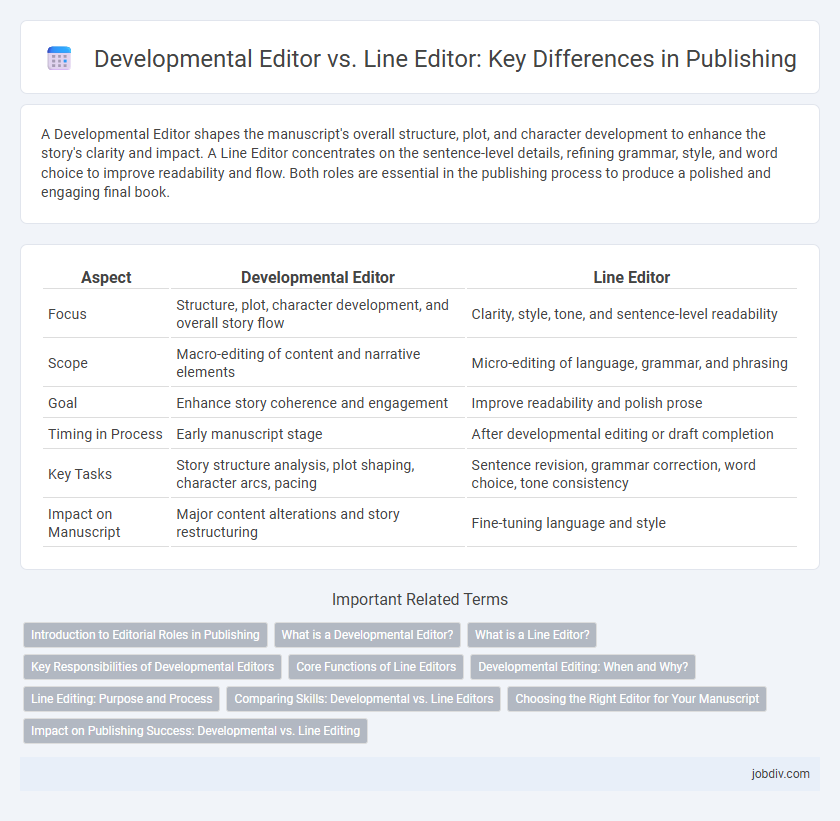A Developmental Editor shapes the manuscript's overall structure, plot, and character development to enhance the story's clarity and impact. A Line Editor concentrates on the sentence-level details, refining grammar, style, and word choice to improve readability and flow. Both roles are essential in the publishing process to produce a polished and engaging final book.
Table of Comparison
| Aspect | Developmental Editor | Line Editor |
|---|---|---|
| Focus | Structure, plot, character development, and overall story flow | Clarity, style, tone, and sentence-level readability |
| Scope | Macro-editing of content and narrative elements | Micro-editing of language, grammar, and phrasing |
| Goal | Enhance story coherence and engagement | Improve readability and polish prose |
| Timing in Process | Early manuscript stage | After developmental editing or draft completion |
| Key Tasks | Story structure analysis, plot shaping, character arcs, pacing | Sentence revision, grammar correction, word choice, tone consistency |
| Impact on Manuscript | Major content alterations and story restructuring | Fine-tuning language and style |
Introduction to Editorial Roles in Publishing
Developmental editors focus on the overall structure, content, and flow of a manuscript, ensuring that the narrative, pacing, and character development align with the author's vision and target audience. Line editors concentrate on sentence-level clarity, style, grammar, and consistency to enhance readability and polish the text. Both editorial roles are essential in the publishing process to refine manuscripts and prepare them for publication.
What is a Developmental Editor?
A developmental editor focuses on the overall structure, content, and flow of a manuscript, helping authors enhance plot, character development, pacing, and thematic consistency. They provide in-depth feedback to shape the narrative, strengthen the argument, and ensure the work fulfills its intended purpose. Their role is crucial during the early stages of manuscript creation to refine big-picture elements before line-level edits begin.
What is a Line Editor?
A line editor focuses on the sentence-level refinement of a manuscript, enhancing clarity, flow, and style by carefully examining grammar, word choice, and sentence structure. This role differs from a developmental editor who addresses overarching elements such as plot, pacing, and character development. Line editors ensure the prose is polished and consistent, making the text engaging and readable without altering the story's foundation.
Key Responsibilities of Developmental Editors
Developmental editors focus on shaping the overall structure, content, and flow of a manuscript, ensuring the story or argument is coherent and logically organized. They work closely with authors to enhance character development, pacing, and thematic depth, often suggesting major revisions or reorganization. Their key responsibilities include evaluating plot consistency, strengthening narrative arcs, and aligning the manuscript with target audience expectations.
Core Functions of Line Editors
Line editors focus on refining sentence structure, grammar, and word choice to enhance clarity and flow within the manuscript. They ensure consistency in tone, style, and punctuation, addressing issues at the sentence and paragraph level. This role complements developmental editing by polishing the text after structural concerns have been resolved.
Developmental Editing: When and Why?
Developmental editing is essential during the early stages of manuscript creation to shape plot, structure, and character development, ensuring the story's coherence and engagement. It addresses big-picture elements like pacing, theme consistency, and narrative flow, making it ideal before line editing. Authors benefit from developmental editing to refine their work's foundation and create a compelling, well-organized manuscript ready for detailed polishing.
Line Editing: Purpose and Process
Line editing refines the manuscript by enhancing sentence structure, word choice, and tone to ensure clarity and flow. Its purpose is to improve readability and maintain the author's voice while correcting grammar, punctuation, and syntax errors at the sentence level. The process involves a detailed review of the text line by line, focusing on style, consistency, and coherence without altering the overall content or structure.
Comparing Skills: Developmental vs. Line Editors
Developmental editors excel in big-picture skills such as plot structure, character development, and narrative pacing, ensuring the manuscript's overall coherence and flow. Line editors focus on sentence-level clarity, style consistency, grammar, and word choice to enhance readability and polish. Both roles require strong editorial expertise but differ fundamentally in their focus areas and technical skills within the publishing process.
Choosing the Right Editor for Your Manuscript
Choosing the right editor for your manuscript depends on the stage and type of revisions needed--developmental editors focus on structure, content, and overall story development, while line editors concentrate on language, style, and clarity at the sentence level. Authors aiming to enhance plot coherence, character development, and pacing benefit from developmental editing, whereas those polishing grammar, word choice, and flow require line editing. Understanding these distinctions ensures efficient collaboration and a stronger, more polished final manuscript.
Impact on Publishing Success: Developmental vs. Line Editing
Developmental editors shape the overall structure, content, and narrative flow, significantly enhancing a manuscript's clarity and market appeal, which directly influences publishing success by increasing reader engagement and sales potential. Line editors focus on sentence-level clarity, grammar, and style consistency, ensuring polished prose that maintains professional standards and reader retention. Both roles are crucial; developmental editing lays the foundation for a compelling story, while line editing refines language, together maximizing the book's impact in the competitive publishing market.
Developmental Editor vs Line Editor Infographic

 jobdiv.com
jobdiv.com